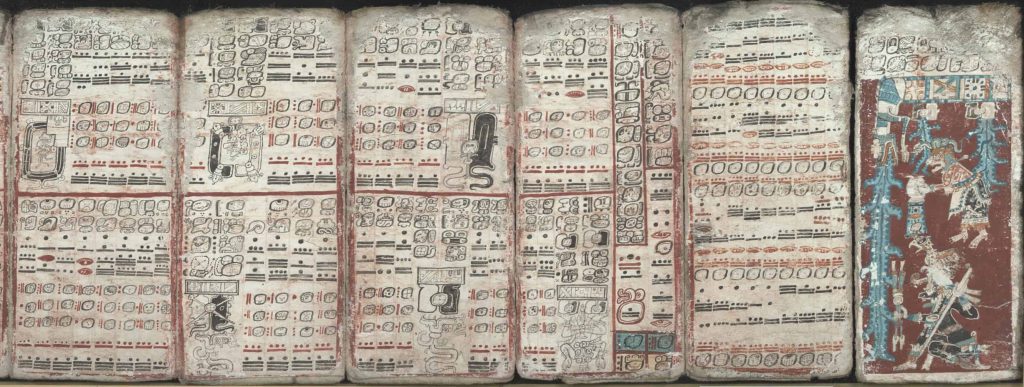The Maya Calendar – Part 1 – Introduction – How does it work?
This post “The Maya Calendar” is an excerpt of the second edition of my book “The Maya Sites – Hidden Treasures of the Rain Forest”, a travel guide to the most important Maya sites on the Yucatán peninsula – in México and Guatemala. The second edition will be published as print and ebook in spring 2018.
I split this article into seven parts:
- The Maya calendar – Part 1 – Introduction <<– You are here
- The Maya calendar – Part 2 – Haab, the Solar Year
- The Maya calendar – Part 3 – Tzolkin, the Sacred Calendar
- The Maya calendar – Part 4 – The Calendar Round
- The Maya calendar – Part 5 – The Long Count
- The Maya calendar – Part 6 – The Numbers and the Vigesimal System
- The Maya calendar – Part 7 – Dates and Numbers in the Inscriptions
The Maya Calendar – Part 1 – Introduction
In addition to their splendid buildings and pottery, the Maya left a large number of written evidence. These inscriptions can be found on the buildings, but also together with murals indoors, on painted ceramics or jewelry made of jade.
In the classical period many stone stelae were erected, on which in addition to the pictures of the rulers, additional written information can be found. These inscriptions cover a mixture of dates and events that had a certain importance to the ruling class.

The Maya Codices
Books were widely used by the Maya, the so-called codices. By the 5th century, the Maya had invented the production paper that they fabricated using tree bark. They called the material Huun and used it for the production of clothes as well.
The codices consisted of pages of about 20 cm height. These single papers were joined together in the manner of a concertina. They could reach a length of several meters in the unfolded state.
Only four of these Maya codices have been preserved. When the Spaniards reached Yucatán there must have been hundreds maybe even thousands of these books, but the Christian monks burned them wherever they could get hold of them.
Diego de Landa, the second bishop of Yucatán, was personally responsible for such a book burning and noted this in his records. But many books, that might have existed once, have simply fallen victim to the ravages of time.
Books have been found as grave goods in several Maya burials. Due to the hot and humid climate in the Maya region, only rotten remains are left over.
Precisely because only a few written evidence has survived to this day, the inscriptions are of particular importance for the understanding of the ancient Maya culture.
The decipherment has only been successful in recent decades. For a long time, the research community was puzzled and archaeologists argued about what significance the signs might have. Basically, since 1863, they had the key in their hands but didn’t realize it.
At that time, a handwritten copy of the previously lost work of Diego de Landa from 1566, the “Report from Yucatán” was discovered in a Spanish library. Unfortunately, this is just an incomplete copy of the original, made up of 3 different incomplete copies.
Anyway. Not only does Diego de Landa provide the “De Landa alphabet”, the key to the Maya script, he also describes parts of the calendar presented below and a very in-depth description of the postclassic history of northern Yucatán and beyond.
Diego de Landa – Destroyer and Keeper of the Maya culture
De Landa wrote down everything of importance to him, producing a fairly accurate description of the Maya’s environment, as he himself could observe.
Of course, Diego de Landa was not an anthropologist and certainly not a linguist. No, as can be seen in several passages in his book, he was a typical Christian committed to the Catholic faith of the late Middle Ages, the same faith that accompanied the Spanish conquest, which took place under the guise of proselytizing.
His report is written from this point of view, but quite benevolently describes the simple people. On the other side, by nature, it has nothing but contempt for the original religion of the Maya.
At the same time, he has given no particular effort in the description of the script so that the Mayan researchers kept his notes for a long time for fantasies.
I suppose that a combination of antipathy, because of the burning of the codices and a good dose of bias because of his Spanish-Catholic origin played an important role during the early period of decipherment and led to a complete disregard of de Landa’s work.
After all, it was the Russian linguist Juri W. Knorosow based in the Soviet Union who succeeded in decoding the code using the Landa alphabet in 1952.
If only they had looked closer!
The Inscriptions of the Maya
About 800 individual hieroglyphical “characters” have been found so far and most of them can be read nowadays.
An excellent book dealing with the historical and scientific aspects of deciphering has been published by Michael D. Coe: Breaking the Maya Code.
But before I start describing the script, I want to introduce the calendar system of the Maya, because it is the basis for many of the inscriptions.
At the end of this series of articles, you will be able to decipher simple calendar data in inscriptions on your own, so you can figure out what time period an inscription is supposed to be from.
The Maya Calendar in the New Age movement
In 2007, when I made a stopover in Austin, Texas on my return from a trip to the Yucatán Peninsula, I was very impressed by the number of books about the culture of the Maya that I found in what is said to be the largest bookstore in the USA.
A year later, when I visited the same bookstore again returning from a trip to Guatemala, I was almost overwhelmed on the same spot by a large number of pseudo-scientific and spiritual-esoteric treatises on the alleged prophesied end of the world on 21.12.2012.
So-called “Maya experts” explained in long essays their New Age interpretation of the Maya calendar, its impact on human history and the fate of the world in general. There speculations about the effects ranging from the end of the world to a tremendous raising consciousness of the human race.
In the meantime, several years have passed and everyone should have noticed:
The “date of fate” left by the ancient Maya carved into a stone slab more than 1000 years ago has passed the world without leaving any traces. The world has still not gone down and humanity is as stupid or smart as it was before that date.
The only thing that might have changed by this doomsday hype was the balance of the doomsday experts.
The Maya Calendar – a System of Calendar Cycles
Nonetheless, the Maya calendar, which dates back to its origins to the mysterious Olmec culture, is a fascinating phenomenon. And a relatively complicated one, due to the fact, that it is not a single calendar, but several, different interlocking calendar cycles.
In this article, I will try to explain the Maya calendar system in as simple a way as possible so that even non-mathematicians understand how this complex system worked.
Like many other cultures whose livelihood was agriculture, the Maya developed a calendar system that allowed them to set recurring dates for sowing their crops. Findings made in the area seem to indicate that the Maya first adopted and then developed an even simpler and earlier form of the calendar from the Olmecs.
Parts of the Maya calendar are still in use in Maya communities in the highlands of Guatemala, but in northern Yucatán as well. In Guatemala, the so-called “calendar bearer” are appointed. They act as advisors in their village communities, administer the calendar knowledge and pass it on to the next generation. In Yucatán, traditional Maya ceremonies include various activities related to sowing and harvesting.
Later, the calendars evolved into a system of prophecies and interpretations of fate, comparable to the system of astrology. De Landa suggests this fact in his report from Yucatán
I will explain the different parts of the Maya calendar individually in the following parts of this article.
Continue with >>> The Maya calendar – Part 2 – Haab, the Solar Year












